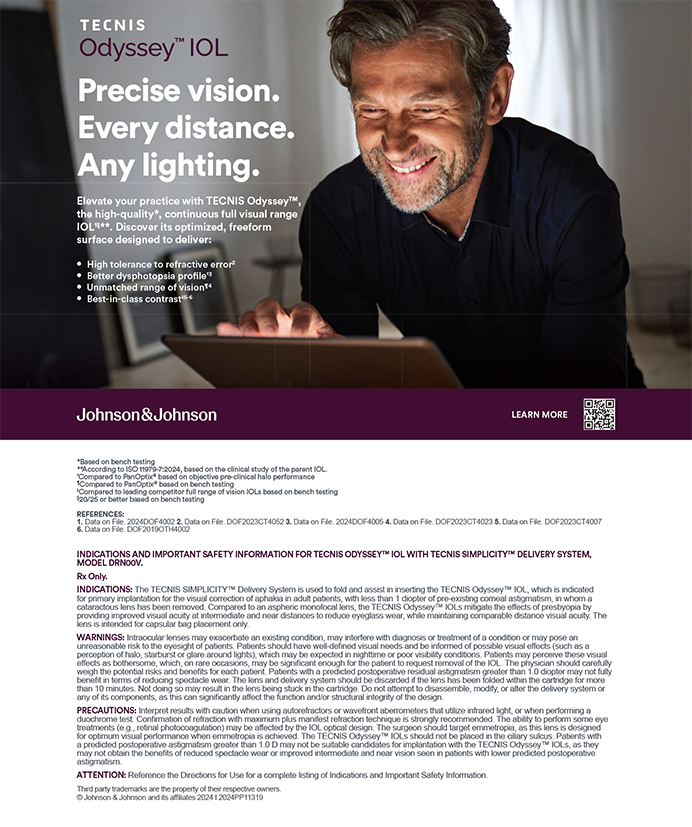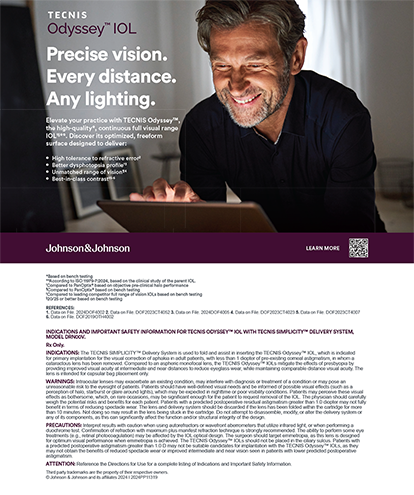Surgical intervention for dense congenital cataracts occurs when patients are between 4 and 8 weeks of age.1 If surgery takes place too early, the incidence of anesthesia-related complications and aphakic/pseudophakic glaucoma is higher. If it occurs too late, dense amblyopia may become untreatable (in unilateral cases), or permanent deprivation nystagmus may develop (bilateral cases). These eyes are often microphthalmic with varying degrees of developmental arrest in the cornea, iris, drainage angle, and retina. The spectrum of persistent fetal vasculature is present in up to 25% of all congenital lens opacities, and it may complicate the surgical treatment and add to the risk of glaucoma and retinal complications.2 After surgery in infancy, a myopic shift of up to 10.00 D will occur in the first year alone.
When toddlers or children in primary school present with developmental cataracts, deciding when to operate may be difficult. A dense opacity in only a portion of the lens or a more diffuse lamellar opacity of only moderate density may allow visual development to proceed normally and may not necessitate immediate surgery. In children, cataract surgery eliminates smooth, youthful accommodation and, more importantly, removes the eye's natural offset to the axial growth of the globe. As the axial length increases, the crystalline lens changes shape to compensate, allowing for a relatively stable refraction over time. The surgeon must decide whether the blur created by the partial cataract justifies eliminating the eye's natural mechanisms of emmetropization and accommodation. The surgical result can be more amblyogenic than the cataract. Often, this judgment must be made for preliterate children who cannot cooperate for Snellen letter visual acuity testing.
Once the ophthalmologist decides to operate on a child, the surgery itself is complex and challenging. A propensity for increased postoperative inflammation and capsular opacification, a refractive state that is constantly changing due to the growth of the eye, poor compliance with postoperative medications, and a tendency to develop amblyopia are among the factors that make cataract surgery in a child different from that in an adult.3-5
THE INCISION
In infants, when an IOL is not being implanted, only two small clear corneal paracentesis incisions are needed to accomplish the lensectomy, central capsulectomy, and vitrectomy (Figure 1). No phaco power is necessary. A tight fit is required to ensure chamber stability in the soft eye of an infant. At the conclusion of the surgery, a silicone contact lens can be placed without the need for a patch or shield, because the incisions are very small and are usually sutured. A specially derived A-constant allows the contact lens power to be selected using the biometry measurements performed under anesthesia.6
When an IOL is being implanted, the corneal tunnel is typically located superiorly rather than temporally, because children frequently rub their eyes after surgery. Infants and small children usually do not have an overhanging brow or a deep-set orbit. The superior tunnel is protected under the brow and by the Bell phenomenon. The recommended closure material is a 10–0 synthetic absorbable suture.
ANTERIOR CAPSULOTOMY
The anterior capsule in children is highly elastic; it has twice the extensibility and five times the tensile strength of the elderly adult capsule. During the creation of a continuous curvilinear capsulorhexis in a child, the direction of pull is more often toward the center of the pupil, 90º from the direction of the tear. A mechanized vitrectorhexis has proven to be a highly effective alternative for infants where the capsulorhexis may be difficult to control.7 Care should be taken to avoid leaving any rightangled edges, which could increase the risk of a radial tear.
ASPIRATION OF THE LENS
Bimanual I/A techniques are preferred. Iris hooks or rings may be needed for immature irides, but these instruments must be gently used. The tissues in pediatric patients are easily damaged, leading to a fibrinous reaction and poor cosmesis of the pupil. When using the vitrector, the surgeon can employ intermittent bursts of cutting to facilitate the aspiration of the “gummy” cortex of young children. As in adults, cortical cleanup must be meticulous. Phacoemulsification is not required, however, and in these soft eyes, it is actually not recommended.
MANAGEMENT OF THE POSTERIOR CAPSULE
The advent of vitreous suction cutting devices for removing the center of the posterior capsule and the anterior vitreous during young children's initial cataract procedure has dramatically decreased their need for secondary surgery.8 A primary posterior capsulotomy and anterior vitrectomy during the IOL's implantation give these patients the best chance of maintaining a clear visual axis for the long term. The new high-speed, smallgauge vitrectomy instruments reduce vitreoretinal traction, inflammation, and long-term retinal risks. Our preferred gauge for vitrectomy and capsulectomy is 25, even if the lens aspiration has been done with a higher gauge.
The posterior capsulorhexis can be performed manually, or a round capsulectomy can be created with a vitrector. Anterior segment surgeons are often more accustomed to, and more comfortable with, a limbal (or anterior) approach to the vitreous and posterior capsule. Pediatric surgeons, however, frequently prefer to perform these procedures via the pars plana/plicata after the IOL is in place (Figure 2).
When the posterior capsule is left intact, opacification most commonly occurs 12 to 24 months after surgery regardless of the patient's age. In children younger than 5 years of age, a primary posterior capsulotomy and anterior vitrectomy are an essential step. For children 5 to 8 years of age, a posterior capsulotomy/capsulectomy is essential, but the vitreous face can be left intact. In children older than 8 years of age, an intact posterior capsule is appropriate unless a posterior capsular plaque is present. An Nd:YAG laser capsulotomy, if needed, should be performed during the early stages of opacification. Once the posterior capsular opacity thickens, a pars plana central capsulectomy may be needed. Even a successful Nd:YAG capsulotomy opening will spontaneously close in one-third of the cases because of the growth of lens epithelial cells and the formed vitreous face.9
IMPLANTATION OF THE IOL
Primary Procedure
By general consensus, IOL implantation is appropriate for most children undergoing cataract surgery after their first birthday. Results of the Infant Aphakia Treatment Study suggest that, until long-term follow-up data are available, surgeons should exercise caution when implanting an IOL in children aged 6 months or younger, given the higher incidence of adverse events and the absence of an improved short-term visual outcome compared with the use of contact lenses.10
Single-piece acrylic IOLs are especially suited to infants and young children. These lenses can be inserted into a small capsular bag with relative ease. When capsular fixation is not possible (usually the case with a secondary IOL after years of aphakia), it is acceptable to place the IOL in the sulcus. When a three-piece acrylic IOL is placed in the sulcus, optic capture through the anterior or combined anterior-posterior capsulorhexis improves centration and prevents pupillary capture. In our experience, the single-piece hydrophilic C-flex IOL (Rayner Intraocular Lenses Ltd.) can be fixated either in the sulcus or the capsular bag, and this lens is a good choice for secondary sulcus fixation in children.
Multifocal Lens
Children who receive an IOL have an ever-changing
refractive error and often have uncorrected cylinder
as well. They therefore may experience significant blur
with multifocal IOLs because of the simultaneous
vision concept. Despite an uptick in the use of multifocal
IOLs for children in their late teen-aged years
when axial growth is nearly complete, these lenses may
not be advantageous in younger, growing, or amblyopic
eyes. With the myopia that develops after ocular
growth, even in the second decade of life, multifocality
may (ironically) result in more spectacle dependence
compared to a monofocal IOL in an eye with residual
myopia. This later endpoint results in a high degree of
satisfaction among older children.
INTRACAMERAL DRUGS
Pediatric eyes have a more vigorous healing response than adults', and children's compliance with postoperative medications is more difficult to ensure. In addition, because a planned vitrectomy and posterior capsulectomy are often performed, the risk of endophthalmitis may be higher in children as well.
Currently, we inject 1 to 2 mg (0.025-0.05 mL) of triamcinolone acetonide (Triesence; Alcon Laboratories, Inc.) intracamerally at the end of surgery in most children. Next, we inject an antibiotic to swirl the triamcinolone. This step helps us to identify any vitreous wick that may have gone unnoticed. Our current antibiotic of choice for intracameral placement is 0.1 mL of a 50% solution of moxifloxacin (Vigamox; Alcon Laboratories, Inc.) in balanced salt solution.
CONCLUSION
The surgical management of cataracts in children differs markedly from that for adults. Surgical principles need to be modified accordingly. Ophthalmologists must take into consideration children's long expected lifespan after the procedure. The use of vitrectomy and capsulectomy is essential in young children, and machines driven by a Venturi pump are preferred. The popularity of intracameral medications is growing among pediatric surgeons, because children's postoperative compliance with a prescribed drug regimen cannot be guaranteed.
Surgical techniques for children continue to evolve along a unique path, influenced by innovations in both the adult cataract and adult vitreoretinal subspecialties.
The use of IOLs in children and the use of intracameral, nonpreserved moxifloxacin and of intracameral, nonpreserved triamcinolone are considered off label.
Supported in part by an unrestricted grant to Medical University of South Carolina-Storm Eye Institute from Research to Prevent Blindness, Inc.
Rupal H. Trivedi, MD, MSCR, is a research associate professor at the Medical University of South Carolina-Storm Eye Institute in Charleston, South Carolina. She acknowledged no financial interest in the products or companies mentioned herein.
M. Edward Wilson, MD, is the Miles professor of ophthalmology and pediatrics at the Medical University of South Carolina-Storm Eye Institute in Charleston, South Carolina. He acknowledged no financial interest in the products or companies mentioned herein. Dr. Wilson may be reached at (843) 792-7622; wilsonme@musc.edu.
- Birch EE, Stager DR. The critical period for surgical treatment of dense congenital unilateral cataract. Invest Ophthalmol Vis Sci. 1996;37(8):1532-1538.
- Wilson ME, Trivedi RH, Morrison DG, et al; Infant Aphakia Treatment Study Group. The Infant Aphakia Treatment Study: evaluation of cataract morphology in eyes with monocular cataracts. J AAPOS. 2011;15(5):421-426.
- Trivedi RH, Wilson ME. Pediatric cataract: preoperative issues and considerations. In: Wilson ME, Saunders RA, Trivedi RH, eds. Pediatric Ophthalmology: Current Thought and a Practical Guide. New York: Springer; 2009:311-324.
- Wilson ME, Trivedi RH. Pediatric cataract surgery: operative and postoperative issues. In: Wilson ME, Saunders RA, Trivedi RH, eds. Pediatric Ophthalmology: Current Thought and a Practical Guide. New York: Springer; 2009:326- 343.
- Wilson ME, Trivedi RH. Pediatric Cataract Surgery: Technique, Complications and Management. Philadelphia: Lippincott Williams & Wilkins. In press.
- Trivedi RH, Wilson ME. Selection of an initial aphakic contact lens power for infantile cataract surgery. Ophthalmology. In press.
- Wilson ME Jr. Anterior lens capsule management in pediatric cataract surgery. Trans Am Ophthalmol Soc. 2004;102:391-422.
- Parks MM. Posterior lens capsulectomy during primary cataract surgery in children. Ophthalmology. 1983;90:344-345.
- Stager DR Jr, Wang X, Weakley DR Jr, Felius J. The effectiveness of Nd:YAG laser capsulotomy for the treatment of posterior capsule opacification in children with acrylic intraocular lenses. J AAPOS. 2006;10:159-63.
- Infant Aphakia Treatment Study Group, Lambert SR, Buckley EG, Drews-Botsch C, et al. A randomized clinical trial comparing contact lens with intraocular lens correction of monocular aphakia during infancy: grating acuity and adverse events at age 1 year. Arch Ophthalmol. 2010;128:810-818.


